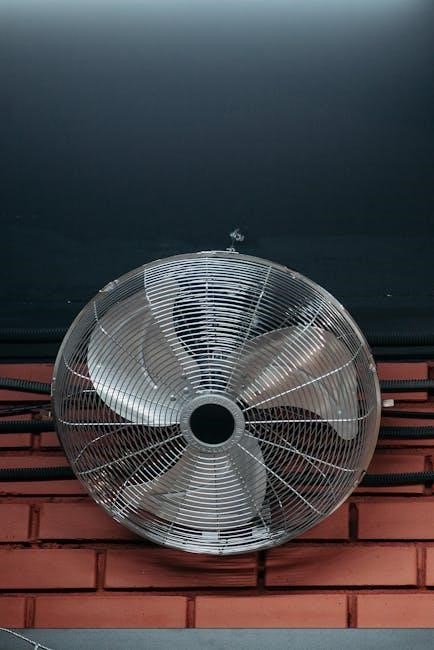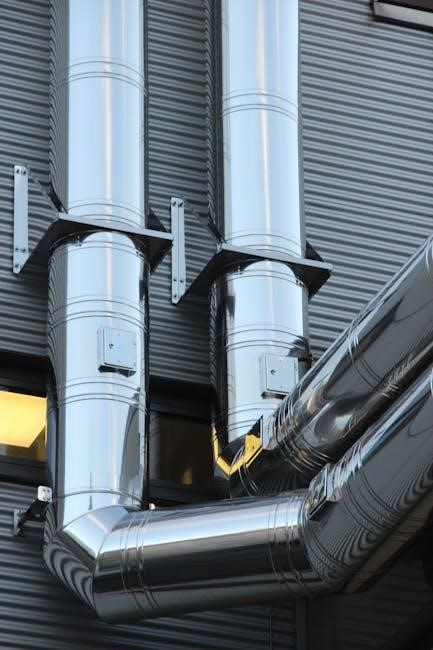Understanding HVAC terminology is crucial for optimizing indoor comfort and system efficiency․ A comprehensive HVAC terms and definitions PDF provides clear explanations of key concepts, from basic components like thermostats and ductwork to advanced technical terms such as psychrometrics and pressure measurements․ These guides are essential for homeowners, students, and professionals seeking to master HVAC systems and improve their expertise․
Understanding the Basics of HVAC
HVAC systems are essential for controlling indoor climate and air quality․ These systems combine heating, ventilation, and air conditioning to maintain thermal comfort and air purity․ Key components include thermostats, which regulate temperature, ductwork, which distributes air, and heat pumps, which provide heating and cooling․ Understanding these basics helps homeowners and professionals communicate effectively and optimize system performance․
By grasping fundamental concepts like psychrometrics and pressure measurements, users can better manage energy efficiency and sustainability․ This knowledge is vital for troubleshooting and maintaining HVAC systems effectively․
Importance of HVAC Terminology
Mastering HVAC terminology is essential for effective communication and problem-solving․ Clear definitions of terms like PSI, Psychrometrics, and PTAC ensure professionals and homeowners understand system operations․
This knowledge enhances efficiency, sustainability, and comfort by enabling precise diagnoses and solutions․ Downloadable PDF guides offer quick access to these definitions, making them indispensable for learning and reference․ Accurate terminology use is crucial for maintaining and optimizing HVAC systems, ensuring they function at peak performance while reducing energy costs․
Overview of HVAC Systems
HVAC systems integrate heating, ventilation, and air conditioning to regulate indoor air quality and temperature․ These systems ensure comfort, health, and energy efficiency in residential and commercial spaces․ They operate by circulating conditioned air, removing moisture, and maintaining humidity levels․ HVAC systems can be centralized or decentralized, using technologies like forced air, radiant heating, or chilled water․ Proper installation, maintenance, and control are essential for optimal performance․ Understanding HVAC systems is vital for managing energy consumption and creating sustainable environments․ This overview provides a foundational understanding of how HVAC systems function and their role in modern buildings․

Key HVAC Components
Key HVAC components include the furnace, condenser, evaporator coil, compressor, blower motor, thermostat, ductwork, refrigerant lines, and air filters, all working together to regulate climate․
Heating Systems: Definitions and Functions
Heating systems are designed to generate and distribute warmth within a building, ensuring comfort during colder months․ These systems can be categorized into different types, including furnaces, heat pumps, and boilers․ Furnaces heat air using fuel sources like natural gas or electricity, while heat pumps transfer heat from one location to another․ Boilers produce hot water or steam, which is circulated through radiators or underfloor systems․ Key components include burners, heat exchangers, blowers, and distribution networks like ducts or pipes․ Their primary function is to maintain desired indoor temperatures efficiently, with modern systems emphasizing energy conservation and reduced emissions․
Ventilation Systems: Types and Purposes
Ventilation systems are designed to maintain air quality by exchanging stale indoor air with fresh outdoor air․ They are crucial for removing pollutants, moisture, and odors, while also controlling humidity levels․ Common types include natural ventilation, which relies on windows and vents, and mechanical ventilation, which uses fans and ducts to circulate air․ Hybrid systems combine both methods for efficiency․ The primary purposes of ventilation systems are to enhance indoor air quality, prevent mold growth, and create a healthier environment․ Proper ventilation also supports energy efficiency by reducing the load on heating and cooling systems, ensuring optimal performance year-round․
Air Conditioning Systems: Principles and Terminology
Air conditioning systems are designed to cool, dehumidify, and circulate air for thermal comfort․ They operate on the refrigeration cycle, which involves compression, condensation, expansion, and evaporation․ Key components include compressors, condensers, expansion valves, and evaporators․ Terminology like “cooling capacity” (measured in BTUs) and “efficiency ratings” (EER, SEER, SEER2) are essential․ Types of systems include window units, split systems, and central AC․ Proper airflow and refrigerant management ensure optimal performance․ Understanding terms like “dehumidification” and “latent cooling” helps in maintaining air quality and comfort․ Regular maintenance, such as coil cleaning, is vital for efficiency and longevity․

Technical HVAC Terms
Technical HVAC terms encompass scientific principles like thermodynamics and fluid dynamics, requiring precise measurements and calculations․ Essential for engineers and technicians to design and maintain efficient systems effectively․
Psychrometrics: The Study of Air Properties
Psychrometrics is the study of air properties, focusing on humidity, temperature, and air quality․ It involves understanding how moisture interacts with air in HVAC systems․ Key terms include absolute humidity, relative humidity, and enthalpy․ Psychrometric charts visualize these relationships, aiding in system design․ By analyzing air’s thermal and moisture properties, HVAC professionals optimize heating, cooling, and ventilation․ Proper psychrometric control ensures comfort, prevents condensation, and maintains indoor air quality․ This field is crucial for designing efficient systems that balance humidity and temperature effectively in various environments․
Thermodynamics in HVAC: Key Concepts
Thermodynamics in HVAC focuses on energy transfer and its applications in heating, cooling, and ventilation systems․ It involves understanding the first and second laws of thermodynamics, which govern energy conservation and entropy․ Key concepts include heat transfer (conduction, convection, radiation), enthalpy (total energy of air), and entropy (measure of disorder)․ These principles are crucial for designing efficient systems, such as heat pumps and refrigeration cycles․ Thermodynamics also explains how HVAC systems manage energy exchange to maintain desired indoor conditions, ensuring optimal performance and efficiency in various applications․
Pressure and Flow Rates: PSI and CFM Explained
Pressure and flow rates are critical in HVAC systems, measured in PSI (Pounds per Square Inch) and CFM (Cubic Feet per Minute)․ PSI measures the pressure of fluids or gases, essential for ducts, pipes, and equipment operation․ CFM indicates airflow volume, vital for ventilation and system performance․ Proper pressure and flow balance ensure efficiency, comfort, and prevent issues like leakage or inadequate heating/cooling․ Technicians use tools like manometers and anemometers to measure these values․ Maintaining optimal levels is key to system reliability and energy efficiency, ensuring HVAC systems function as designed․

HVAC Abbreviations and Acronyms
HVAC abbreviations and acronyms simplify communication, ensuring clarity and efficiency․ Common terms like AFUE ( Annual Fuel Utilization Efficiency ) and SEER ( Seasonal Energy Efficiency Ratio ) are widely used․
Common HVAC Acronyms: AFUE, SEER, HSPF
Understanding common HVAC acronyms is essential for evaluating system performance․ AFUE (Annual Fuel Utilization Efficiency) measures furnace efficiency, indicating how much fuel is converted into usable heat․ SEER (Seasonal Energy Efficiency Ratio) assesses cooling systems, calculating efficiency over a cooling season․ HSPF (Heating Seasonal Performance Factor) evaluates heat pumps’ efficiency during heating modes․ These metrics help consumers and professionals compare systems and make informed decisions․ Higher ratings typically mean greater energy efficiency and lower operational costs․ These acronyms are key to understanding HVAC system ratings and performance standards․
Understanding Industry-Specific Abbreviations
Industry-specific abbreviations in HVAC are crucial for clear communication and accurate system specifications․ R-22 and R-410A refer to common refrigerants, with R-410A being more environmentally friendly․ DOE (Department of Energy) sets efficiency standards, while NATE (North American Technician Excellence) certifies technicians․ AHRI (Air-Conditioning, Heating, and Refrigeration Institute) is a key organization for product certification․ These abbreviations are often used in manuals, specifications, and compliance documentation․ Understanding them ensures proper system installation, maintenance, and compliance with regulations․ They simplify complex terms, making HVAC discussions more efficient for professionals and enthusiasts alike․

HVAC Tools and Instruments
Essential HVAC tools include multimeters, infrared cameras, vacuum pumps, manometers, duct testers, thermometers, hygrometers, anemometers, and leak detectors․ These instruments ensure accurate measurements and system diagnostics․
Thermostats: Function and Types
Thermostats are essential tools in HVAC systems, regulating temperature by controlling heating and cooling operations․ They function by sensing room temperature and activating systems to maintain set levels․ Types include mechanical, digital, smart, and wireless thermostats․ Mechanical thermostats use physical expansion to operate, while digital ones offer precise control via electronic interfaces․ Smart thermostats integrate Wi-Fi connectivity, enabling remote adjustments and energy-saving features․ Programmable thermostats allow scheduling temperature changes, optimizing energy use․ Each type enhances system efficiency and user convenience, ensuring consistent indoor comfort while reducing energy consumption․ Understanding thermostat functionality is crucial for effective HVAC system management and performance․
Manometers and Pressure Gauges
Manometers and pressure gauges are critical tools in HVAC systems, measuring pressure differences and absolute pressure․ Manometers typically measure pressure differences between two points, essential for diagnosing airflow issues or verifying filter conditions․ Pressure gauges, meanwhile, display the absolute pressure of fluids or gases in systems․ Both tools are vital for troubleshooting and maintaining HVAC equipment, ensuring proper operation and safety․ Digital and mechanical versions are available, offering precision and reliability․ Understanding their functions is key to identifying system leaks, imbalances, or improper settings, ensuring optimal performance and energy efficiency in heating, ventilation, and air conditioning applications․
Multimeters and Their Use in HVAC
Multimeters are versatile diagnostic tools essential for HVAC technicians, enabling precise measurements of voltage, current, and resistance․ They are crucial for troubleshooting electrical circuits in HVAC systems, ensuring safe and efficient operation․ Technicians use multimeters to verify power supply, detect short circuits, and check component continuity․ Digital and analog models are available, offering varying levels of precision; Proper use of multimeters is vital for accurate diagnoses, preventing equipment damage and ensuring system reliability․ They are indispensable for maintaining optimal performance and safety in heating, ventilation, and air conditioning systems, helping technicians identify and resolve electrical issues effectively․

HVAC Efficiency and Energy Terms

HVAC efficiency terms include EER, SEER, AFUE, and HSPF, which measure energy performance․ Higher ratings indicate greater efficiency, helping reduce energy consumption and costs effectively․
EER, SEER, and AFUE: Efficiency Ratings
EER (Energy Efficiency Ratio) measures cooling efficiency under fixed conditions, while SEER (Seasonal Energy Efficiency Ratio) reflects efficiency over a cooling season․ AFUE (Annual Fuel Utilization Efficiency) rates furnace performance, indicating how much fuel is converted to usable heat․ Higher ratings mean better efficiency, lowering energy bills and environmental impact․ Understanding these terms helps consumers make informed decisions when selecting HVAC systems․ These ratings are standardized to ensure accurate comparisons between models․ Proper installation and maintenance can optimize efficiency, aligning with energy-saving goals and regulatory standards for eco-friendly solutions in heating and cooling applications․
Energy Efficiency in HVAC Systems
Energy efficiency in HVAC systems is crucial for reducing operational costs and environmental impact․ Modern systems emphasize optimized performance through advanced technologies like smart thermostats and variable-speed compressors․ Proper sizing, insulation, and duct sealing ensure minimal energy loss․ High-efficiency units with superior ratings lower consumption while maintaining comfort․ Regular maintenance, such as cleaning coils and changing filters, enhances efficiency․ Programmable thermostats and zoning systems allow precise temperature control, further conserving energy․ Eco-friendly refrigerants and sustainable practices align HVAC efficiency with green building standards, promoting long-term energy savings and environmental responsibility․
LEED and Green Building Standards
LEED (Leadership in Energy and Environmental Design) and green building standards play a vital role in shaping sustainable HVAC practices․ These standards emphasize energy efficiency, reduced environmental impact, and improved indoor air quality․ HVAC systems must meet specific criteria, such as energy performance benchmarks and the use of eco-friendly materials․ Green building certifications reward systems that minimize energy consumption and incorporate renewable energy sources․ Compliance with LEED standards not only enhances sustainability but also contributes to occupant health and productivity․ By aligning HVAC design with green building principles, professionals can create environmentally responsible and high-performance systems․

HVAC Troubleshooting and Maintenance
HVAC troubleshooting involves identifying and resolving system issues like leaks, sensor malfunctions, or airflow problems․ Regular maintenance ensures optimal performance, prevents breakdowns, and reduces energy costs;
Common HVAC Problems and Solutions
Common HVAC issues include improper airflow, refrigerant leaks, and sensor malfunctions․ Solutions involve checking ducts for blockages, inspecting refrigerant lines for damage, and ensuring sensors are clean․ Faulty thermostats or compressors may require replacement․ Regular filter changes and coil cleaning can prevent efficiency drops․ Homeowners should address strange noises or water leaks promptly to avoid system damage․ Professional maintenance is recommended for complex repairs, ensuring safety and optimal performance․ Understanding these problems and solutions helps users maintain their HVAC systems effectively and extend their lifespan․ Proper troubleshooting guides are essential for DIY fixes and professional interventions․
Maintenance Terminology: Filters, Coils, Ducts
Maintenance terminology includes filters, which remove contaminants from air, ensuring clean circulation․ Regular filter replacement improves indoor air quality and system efficiency․ Coils are heat-exchange components; dirty coils reduce performance and energy efficiency․ Cleaning coils is essential for maintaining proper heat transfer․ Ducts are air distribution pathways; leaks or blockages in ducts waste energy and reduce airflow․ Sealing and insulating ducts optimizes system performance․ Proper maintenance of these components ensures long-term functionality, energy savings, and improved comfort․ Understanding these terms helps in identifying and addressing common HVAC system issues effectively, promoting a healthier and more efficient indoor environment․

HVAC Industry Standards and Certifications
HVAC industry standards and certifications ensure systems meet safety and efficiency requirements․ Key organizations set these guidelines, crucial for professionals to adhere to for optimal performance․
ASHRAE Standards and Guidelines
ASHRAE standards and guidelines are fundamental to the HVAC industry, providing frameworks for energy efficiency, indoor air quality, and system performance․ These standards, such as ANSI/ASHRAE Standard 55 for thermal comfort and Standard 62․1 for ventilation rates, are regularly updated to reflect advancements in technology and best practices․ Compliance with ASHRAE standards ensures that HVAC systems operate effectively while meeting safety and environmental regulations․ Professionals rely on these guidelines to design and maintain systems that promote occupant health and reduce energy consumption, making them indispensable in the field․
NATE and Other HVAC Certifications
NATE (North American Technician Excellence) certification is a prominent credential for HVAC technicians, ensuring expertise in installation, service, and repair․ It validates a technician’s knowledge of HVAC systems, safety protocols, and industry standards․ Other certifications include EPA 608 for refrigerant handling and R-410A certification for newer systems․ These credentials demonstrate adherence to environmental and safety regulations․ Certifications like these enhance credibility, career opportunities, and compliance with industry requirements․ Employers often require them to ensure skilled, efficient, and safe system installations and maintenance․ They play a crucial role in advancing professionalism and excellence within the HVAC industry․

Comprehensive HVAC Glossary
A comprehensive HVAC glossary offers definitions for key terms and acronyms like AFUE, SEER, and CFM, essential for understanding system efficiency, performance, and troubleshooting․
From Absolute Humidity to Zone Control
The glossary covers essential HVAC terms, starting with absolute humidity, referring to the total moisture content in the air․ Other key terms include BTU (British Thermal Unit), measuring heat energy, and CFM (cubic feet per minute), indicating airflow rates․ SEER (Seasonal Energy Efficiency Ratio) evaluates cooling efficiency, while AFUE (Annual Fuel Utilization Efficiency) measures heating efficiency․ Terms like thermostat, ductwork, and condenser explain system components․ The glossary also includes modern concepts like smart HVAC and zone control, allowing precise temperature management․ This resource provides clarity for technicians, homeowners, and industry professionals․




